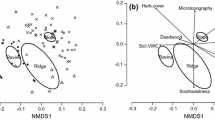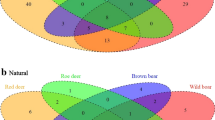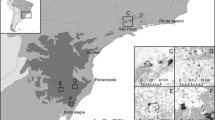Abstract
Ungulates are potentially important seed dispersers for many invasive plant species. While our understanding of which invasive plant species are dispersed by ungulates has improved over the last decade, the factors influencing this process remain poorly understood. To address this, we explored white-tailed deer (Odocoileus virginianus) seed consumption and dispersal of an invasive shrub (Lonicera maackii) in fragmented agricultural-forest matrices in western Ohio. In a pairwise browse preference experiment, deer browsed at similar levels on branches of L. maackii with fruits removed and fruits intact (mean ± 95 % CI 57 ± 14 and 62 ± 14 %, respectively). We found no evidence that white-tailed deer disperse L. maackii seeds along an invasion front, but 31 % of deer pellet groups collected in an invaded area contained germinable L. maackii seeds (maximum number of germinable seeds = 30). By combining hourly movement data specific to fragmented landscapes and gut retention time data, we projected that female deer disperse 91 % of ingested seeds further than 100 m from seed sources (i.e., long-distance seed dispersal), and rarely disperse seeds up to 7.9 km. We conclude that white-tailed deer can be important long-distance seed dispersal vectors of L. maackii, and that invader abundance and/or patch connectivity likely influence patterns of seed dispersal by white-tailed deer.



Similar content being viewed by others
References
Anderson CW, Nielsen CK, Storm DJ, Schauber EM (2011) Modeling habitat use of deer in an exurban landscape. Wildl Soc Bull 35:235–242
Arthur MA, Bray SR, Kuchle CR, McEwan RW (2012) The influence of the invasive shrub, Lonicera maackii, on leaf decomposition and microbial community dynamics. Plant Ecol 213:1571–1582
Barnes TG, Varner LW, Blankenship LH, Gallagher JF (1992) Indigestible particulate passage in white- tailed deer. In: Brown RD (ed) The biology of deer. Springer-Verlag, New York, pp 436–442
Barriball K, McNutt EJ, Gorchov DL, Rocha OJ (2015) Inferring invasion patterns of Lonicera maackii (Rupr) Herder (Caprifoliaceae) from the genetic structure of 41 naturalized populations in a recently invaded area. Biol Invasions 8:1013–1022
Bartuszevige AM, Gorchov DL (2006) Avian seed dispersal of an invasive shrub. Biol Invasions 8:1013–1022
Bartuszevige AM, Gorchov DL, Raab L (2006) The relative importance of landscape and community features in the invasion of an exotic shrub in a fragmented landscape. Ecography 29:213–222
Bee JN, Tanentzap AJ, Lee WG, Lavers RB, Mark AF, Mills JA, Coomes DA (2011) Influence of foliar traits on forage selection by introduced red deer in New Zealand. Basic Appl Ecol 12:56–63
Blyth LH, Ouborg LJ, Johnson DM, Anderson LJ (2013) The short-term germination and establishment success of deer-dispersed seeds in mesic temperate forests. J Torrey Bot Soc 140:334–348
Cain M, Milligan B, Strand A (2000) Long-distance seed dispersal in plant populations. Am J Bot 87:1217–1227
Castellano SM, Gorchov DL (2013) White-tailed deer (Odocoileus virginianus) disperse seeds of the invasive shrub, Amur honeysuckle (Lonicera maackii). Nat Areas J 33:78–80
Christopher CC, Matter SF, Cameron GN (2014) Individual and interactive effects of Amur honeysuckle (Lonicera maackii) and white-tailed deer (Odocoileus virginianus) on herbs in a deciduous forest in the eastern United States. Biol Invasions 16:2247–2261
Clark J, Fastie C, Hurtt G, Jackson ST, Johnson C, King GA, Lewis M, Lynch J, Pacala S, Prentice C, Schpp EW, Webb T III, Wyckoff P (1998) Reid’s paradox of rapid plant migration. Bioscience 48:13–24
Clark CJ, Poulsen JR, Bolker BM, Connor EF, Parker VT (2005) Comparative seed shadows of bird-, monkey-, and wind-dispersed trees. Ecology 86:2684–2694
Collier M, Vankat J, Hughes M (2002) Diminished plant richness and abundance below Lonicera maackii, an invasive shrub. Am Midl Nat 147:60–71
Côté SD, Rooney TP, Tremblay JP, Dussault C, Waller DM (2004) Ecological impacts of deer overabundance. Annu Rev Ecol Evol Syst 35:113–147
Ditchkoff SS (2011) Anatomy and physiology. In: Hewitt DG (ed) Biology and Management of White-tailed Deer. CRC Press, Boca Raton, pp 75–105
Eschtruth AK, Battles JJ (2009) Acceleration of exotic plant invasion in a forested ecosystem by a generalist herbivore. Conserv Biol 23:388–399
Excoffier L, Foll M, Petit RJ (2009) Genetic consequences of range expansions. Annu Rev Ecol Evol Syst 40:481–501
Eycott AE, Watkinson AR, Hemami MR, Dolman PM (2007) The dispersal of vascular plants in a forest mosaic by a guild of mammalian herbivores. Oecologia 154:107–118
Gorchov DL, Castellano SM, Noe DA (2014) Long-distance dispersal and diffusion in the invasion of Lonicera maackii. Invasive Plant Sci Manag 7:464–472
Gorchov D, Trisel D (2003) Competitive effects of the invasive shrub, Lonicera maackii (Rupr.) Herder (Caprifoliaceae), on the growth and survival of native tree seedlings. Plant Ecol 166:13–25
Gould A, Gorchov D (2000) Effects of the exotic invasive shrub Lonicera maackii on the survival and fecundity of three species of native annuals. Am Midl Nat 144:36–50
Guiden PWG (2014) The role of white-tailed deer (Odocoileus virginiana) in long-distance seed dispersal of Amur honeysuckle (Lonicera maackii). Master thesis, Department of Biology, Miami University, Oxford
Hartman K, McCarthy B (2008) Changes in forest structure and species composition following invasion by a non-indigenous shrub, Amur honeysuckle (Lonicera maackii). J Torrey Bot Soc 135:245–259
Heilman G, Strittholt J (2002) Forest fragmentation of the conterminous United States: assessing forest intactness through road density and spatial characteristics. Bioscience 52:411–422
Hewitt DG (2011) Nutrition. In: Hewitt DG (ed) Biology and management of white-tailed deer. CRC Press, Boca Raton, pp 75–105
Hidayati SN, Baskin JM, Baskin CC (2000) Dormancy- breaking and germination requirements of seeds of four Lonicera species (Caprifoliaceae) with underdeveloped spatulate embryos. Seed Sci Res 10:459–469
Hutchinson TF, Vankat JL (1997) Invasibility and effects of Amur honeysuckle in southwestern Ohio forests. Conserv Biol 11:1117–1124
Ingold J, Craycroft M (1983) Avian frugivory on honeysuckle (Lonicera) in southwestern Ohio in fall. Ohio J Sci 83:256–258
Janzen D (1970) Herbivores and the number of tree species in tropical forests. Am Nat 104:501–528
Jaroszewicz B, Pirożnikow E, Sondej I (2013) Endozoochory by the guild of ungulates in Europe’s primeval forest. For Ecol Manag 305:21–28
Jenks J, Leslie D (1989) Digesta retention of winter diets in white-tailed deer (Odocoileus virginianus) fawns in Maine, USA. Can J Zool 67:1500–1504
Johnson A, Hale P, Ford W (1995) White-tailed deer foraging in relation to successional stage, overstory type and management of southern Appalachian forests. Am Midl Nat 133:18–25
Johnston S, Henry M, Gorchov D (2012) Using advanced land imager (ALI) and landsat thematic mapper (TM) for the detection of the invasive shrub Lonicera maackii in southwestern Ohio forests. GIScience Remote Sens 49:450–462
Kjær LJ, Schauber EM, Nielsen CK (2008) Spatial and temporal analysis of contact rates in female white-tailed deer. J Wildl Manag 72:1819–1825
Knight TM, Dunn JL, Smith LA, Davis JA, Kalisz A (2009) Deer facilitate invasive plant success in a Pennsylvania forest understory. Nat Areas J 29:110–116
Mautz W, Petrides G (1971) Food passage rate in the white-tailed deer. J Wildl Manag 35:723–731
McConkey KR, Prasad S, Corlett RT, Campos-Arceiz A, Brodie JF, Rogers H, Santamaria L (2012) Seed dispersal in changing landscapes. Biol Conserv 146:1–13
McNeish RE, Benbow ME, McEwan RW (2012) Riparian forest invasion by a terrestrial shrub (Lonicera maackii) impacts aquatic biota and organic matter processing in headwater streams. Biol Invasions 14:1881–1893
Miller KE, Gorchov DL (2004) The invasive shrub, Lonicera maackii, reduces growth and fecundity of perennial forest herbs. Oecologia 139:359–375
Murray KG (1988) Avian seed dispersal of three neotropical gap-dependent plants. Ecol Monogr 58:271–298
Myers JA, Vellend M, Gardescu S, Marks PL (2004) Seed dispersal by white-tailed deer: implications for long-distance dispersal, invasion, and migration of plants in eastern North America. Oecologia 139:35–44
Ng J, Nielson C, Clair CS (2008) Landscape and traffic factors influencing deer-vehicle collisions in an urban environment. Hum Wildl Confl 2:34–47
Nixon C, Hansen L, Brewer P, Chelsvig J (1991) Ecology of white-tailed deer in an intensively farmed region of Illinois. Wildl Monogr 18:1–77
Pfeiffer SS, Gorchov DL (2015) Effects of the Invasive Shrub Lonicera maackii on soil water content in eastern deciduous forest. Am Midl Nat 173:38–46
Quinn ACD, Williams DM, Porter WF (2013) Landscape structure influences space use by white-tailed deer. J Mammal 94:398–407
Rawsthorne J, Roshier DA, Murphy SR (2009) A simple parametric method for reducing sample sizes in gut passage time trials. Ecology 90:2328–2331
Riitters KH, Coulston JW, Wickham JD (2012) Fragmentation of forest communities in the eastern United States. For Ecol Manag 263:85–93
Rooney TP (2001) Deer impacts on forest ecosystems: a North American perspective. Forestry 74:201–208
Rooney TP, Waller DM (2003) Direct and indirect effects of white-tailed deer in forest ecosystems. For Ecol Manag 181:165–176
Rouleau I, Crete M, Ouellet JP (2002) Contrasting the summer ecology of white-tailed deer inhabiting a forested and an agricultural landscape. Ecoscience 9:459–469
Schaefer HM (2006) The role of chromatic and achromatic signals for fruit detection by birds. Behav Ecol 17:784–789
Schauber E, Storm D, Nielsen C (2007) Effects of joint space use and group membership on contact rates among white-tailed deer. J Wildl Manag 71(1):155–164
Shelton AL, Henning JA, Schultz P, Clay K (2014) Effects of abundant white-tailed deer on vegetation, animals, mycorrhizal fungi, and soils. For Ecol Manag 320:39–49
Stewart KM, Boyer RT, Weisberg PJ (2011) Spatial use of landscapes. In: Hewitt DG (ed) Biology and Management of White-tailed Deer. CRC Press, Boca Raton, pp 75–105
Storm DJ, Nielsen CK, Schauber EM, Woolf A (2007) Space use and survival of white-tailed deer in an exurban landscape. J Wildl Manag 71:1170–1176
Swift CE, Gross MK (2008) Preventing deer damage. Colorado State University extension. (http://www.ext.colostate.edu)
van Beest FM, Mysterud A, Loe LE, Milner JM (2010) Forage quantity, quality and depletion as scale-dependent mechanisms driving habitat selection of a large browsing herbivore. J Anim Ecol 79:910–922
Vangilder L, Torgerson O, Porath W (1982) Factors influencing diet selection by white-tailed deer. J Wildl Manag 46:711–718
Vellend M (2002) A pest and an invader: white-tailed deer (Odocoileus virginianus Zimm.) as a seed dispersal agent for honeysuckle shrubs (Lonicera L.). Nat Areas J 22:230–234
Vellend M, Myers JA, Gardescu S, Marks PL (2003) Dispersal of Trillium seeds by deer: implications for long-distance migration of forest herbs. Ecology 84:1067–1072
Venables WN, Ripley BD (2002) Modern Applied Statistics with S, 4th edn. Springer, New York
Walter WD, VerCauteren KC, Campa H, Clark WR, Fischer JW, Hygnstom SE, Mathews NE, Nielsen CK, Schauber EM, Van Deelen TR, Winterstein SR (2009) Regional assessment on influence of landscape configuration and connectivity on range size of white-tailed deer. Landsc Ecol 24:1405–1420
Warner A (1985) Rate of passage of digesta through birds and mammals. Nutr Abstr Rev Ser B 51:789–820
Wilfong BN, Gorchov DL, Henry MC (2009) Detecting an invasive shrub in deciduous forest understories using remote sensing. Weed Sci 57:512–520
Williams SC, Ward JS (2006) Exotic seed dispersal by white-tailed deer in southern Connecticut. Nat Areas J 26:383–390
Williams DM, Dechen Quinn AC, Porter WF (2011) Landscape effects on scales of movement by white-tailed deer in an agricultural–forest matrix. Landsc Ecol 27:45–57
Acknowledgments
We would like to thank Miami University, the Garden Club of America, and the Garden Club of Ohio for funding this research, Dr. Thomas Crist and Dr. Hank Stevens for their assistance with experimental design and analysis, and Patrick Garrett and Brian Hoven for assistance with data collection. We also want to thank Jack Keegan and the Boyd Greenhouse staff for providing material and care for seedlings, Dr. Ann Rypstra and Rodney Kolb for facilitating the use the Miami University Ecology Research Center, and the landowners in the Darke County study area who gave us permission to use their property in this study. T. Crist, H. Stevens, and several anonymous reviewers provided valuable comments on earlier drafts.
Author information
Authors and Affiliations
Corresponding author
Additional information
Communicated by William E. Rogers.
Appendix
Appendix
See Fig. 4.
Rights and permissions
About this article
Cite this article
Guiden, P., Gorchov, D.L., Nielsen, C. et al. Seed dispersal of an invasive shrub, Amur honeysuckle (Lonicera maackii), by white-tailed deer in a fragmented agricultural-forest matrix. Plant Ecol 216, 939–950 (2015). https://doi.org/10.1007/s11258-015-0480-x
Received:
Accepted:
Published:
Issue Date:
DOI: https://doi.org/10.1007/s11258-015-0480-x





